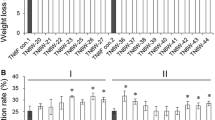Abstract
We studied the capacity of a selected strain of Gloeophyllum trabeum, alone or in combination with Resinicium bicolor, to defibrillate non treated deciduous wood at a semi industrial composting scale. Inoculum amount, aeration of the composted wood, type (freshly cut wood and wood stored since several years) and the quantity of wood used were analysed. The remaining cellular cohesion, lignin and holocellulose, as well as fungal biomass content in the wood after various treatments were determined. Results showed that G. trabeum rapidly colonised the non-sterile substrate and caused greater biodefibrillation compared with the control (non inoculated wood). Effects of the various treatments on biodefibrillation were compared and are discussed.
Similar content being viewed by others
References
Akhtar M, Attridge MC, Myers GC, Blanchette RA (1993) Biomechanical pulping of loblolly pine chips with selected white-rot fungi. — Holzforschung 47: 36–40.
Carreiro MM, Koske RD (1992). Effect of temperature on decomposition and development of microfungal communities in leaf litter microcosms. — Canadian Journal of Botany 70: 2177–2183.
Daniel G, Jellison J, Goodell B, Paszcynski A, Crawford R (1991) Use of monoclonal antibodies to detected Mn(II)-peroxidase in birch wood degraded by Phanerochaete chrysosporium. — Applied Microbiology and Biotechnology 35: 674–680.
Daniel G, Pettersson BN, Nilsoon T, Volc J (1990) Use of inmunogold cytochemistry to detected Mn(II)-dependent and lignin peroxidase in wood degraded by the white rot fungus Phanerochaete chrysosporium and Lentinus edodes. — Canadian Journal of Botany 68: 920–933.
Diouf PN, Delbarren N, Perrin D, Gerardin D, Rapin C, Jacquot JP, Gelhaye J (2002). Influence of tropolone on Poria placenta wood degradation. — Applied and Environmental Microbiology 68: 4377–4382.
Effland MJ (1977) Modified procedure to determine acid insoluble lignin in wood and pulp. — TAPPI 60: 143–144.
Fengel D, Wegener G (1989) Wood chemistry, ultrastructure, reactions. Walter de Gruyter, Berlin.
Flournoy DS, Paul JA, Kirk TK, Highley TL (1993) Changes in the size and volume of pores in sweetgum wood during simultaneous rot by Phanerochaete chrysosporium. — Holzforschung 47: 297–301.
Friis-Hansen HN (1980) A summary of tests and practical experience with the Pilodyn wood testing instrument. Swedish Wood Preservation Institute, Wood Press, IRG/WP/1167.
Job C, Keller J, Job DJ (1996) Degradation of unbleached sulphite pulp paper treated in solid state conditions with the brown-rot Gloeophyllum. — Material und Organismen 30: 105–116.
Job DJ (2002) Assessment of selected decay Basidiomycets for selective biodefibrillation of Picea abies wood. — Mycological Progress 1: 123–129.
Job DJ, Giovannini I (2001) Grifola frondosa (Dicks.: Fr.) S.F. Gray: Optimization of basidiocarp formation and study of its biological activities. — International Journal of Medicinal Mushrooms 3: 164.
Job DJ, Rajchenberg M (1988) Experimental wood-rot of Salix humboldtiana blocks by species of Phellinus (Aphyllophorales). — Material und Organismen 23: 21–29.
Job DJ, Wright JE (1986) Experimental wood-rot of Salix humboldtiana blocks by species of Hymenochaete (Aphyllophorales). — Material und Organismen 21: 301–310.
Kirpatrick N, Reid IN, Ziomek E, Paice M (1989) Relationship between fungal biomass production and the brightening of hardwook kraft pulp by Coriolus versicolor. — Applied and Environmental Microbiology 55: 1147–1152.
Krieglsteiner GJ (2000) Die Grosspilze Baden-Württumbergs. Band 1. Ulmer. Stuttgart.
Leightley LE (1981) The use of the Pylodin (R) as non-destructive test methods for detecting decay in CCA-treated Eucalyptus poles. Swedish Wood Preservation institute, Wood Pres., Doc. IRG/WP/2153.
Messner K (1998) Biopulping. In: Forest Products Biotechnology. A. Bruce and Palfreyman. London.
Niemelä T, Renvall P, Penttilär R (1995) Interactions of fungi at late stages of wood decomposition. — Annales Botanici Fennici 32: 141–152.
Nusbaumer CE, Job DJ, Aragno M (1996) Study of the alteration by fungi of the physico-chemical state of lignocellulosic composites in the natural process of composting. — Mycologia Helvetica 8: 51–67.
Paszczynski A, Crawford R, Funk D, Goodell B (1999) De novo synthesis of 4,5-Dimethoxycotechol and 2,5 dimethoxyhydroquinone by the brown rot Gloeophyllum trabeum. — Applied and Environmental Microbiology 65: 674–679.
Raviv M, Chen Y, Inbar Y (1986) The use of peat and compost as growth media for container-grown plants. In Chen J and Avnimelech Y: The role of organic matter in modern agriculture. Dordrecht.
Raviv M, Zaidman B, Kapulnik Y (1998) The use of compost as a peat substitute for organic vegetable transplant production. — Compost Science and Utilization 6: 46–52.
Sayadi S, Ellouz R (1995) Roles of lignin peroxidase and manganese peroxidase from Phanerochaete chrysosporium in the decolorization of olive mill waste-water. — Applied Environmental Microbiology 61: 1098–1103.
Schmidt O, Grimm K, Moreth U (2002) Molekulare und biologische Charakterisierung von Gloeophyllum — Arten in Gebaüden. — Zeitschrit für Mykologie 68: 141–152.
Seifert TK (1983) Decay of wood by Dacrymycetales. — Mycologia 75: 1011–1018.
Stamets P (1993) Growing gourmets and medicinal mushrooms. Ted Speen Press. Hong Kong. 551 p.
Yang VW, Illman B (1999) Optimun growth conditions for the metal-tolerant wood decay fungus. The Inter. Res. Group on Wood Preserv. Document No IRG/WP 99-50142. 9 p.
Author information
Authors and Affiliations
Rights and permissions
About this article
Cite this article
Job, D. Optimized fungal defibrillation of wood using selected strains of Gloeophyllum trabeum and Resinicium bicolor . Mycol Progress 3, 151–156 (2004). https://doi.org/10.1007/s11557-006-0085-9
Accepted:
Issue Date:
DOI: https://doi.org/10.1007/s11557-006-0085-9




